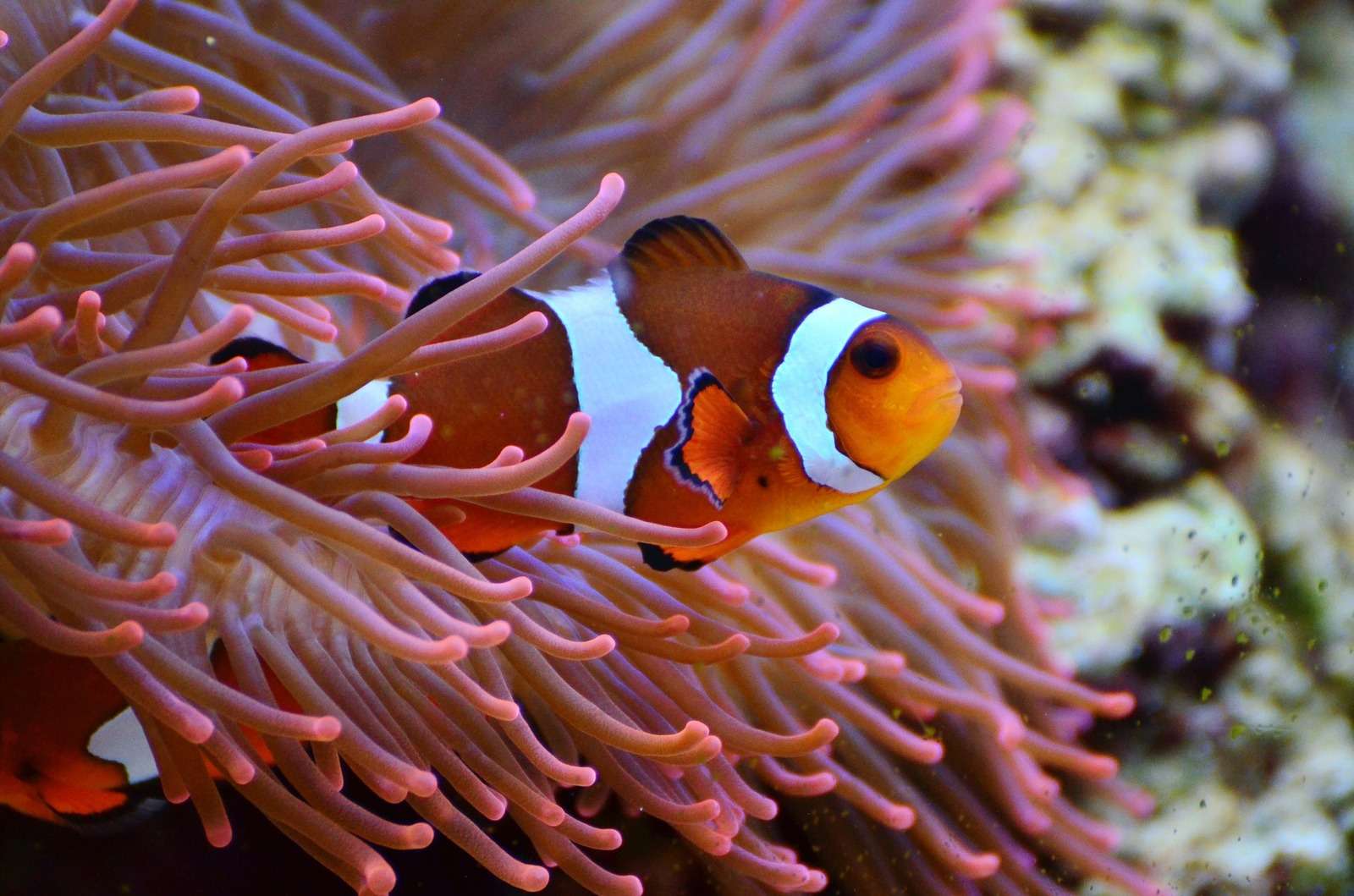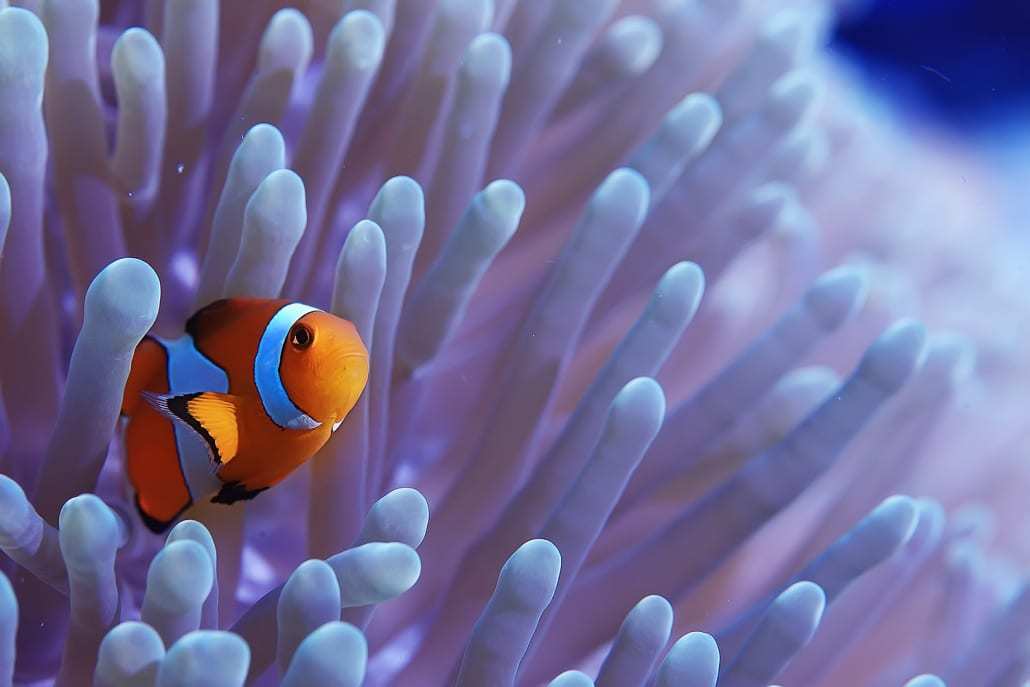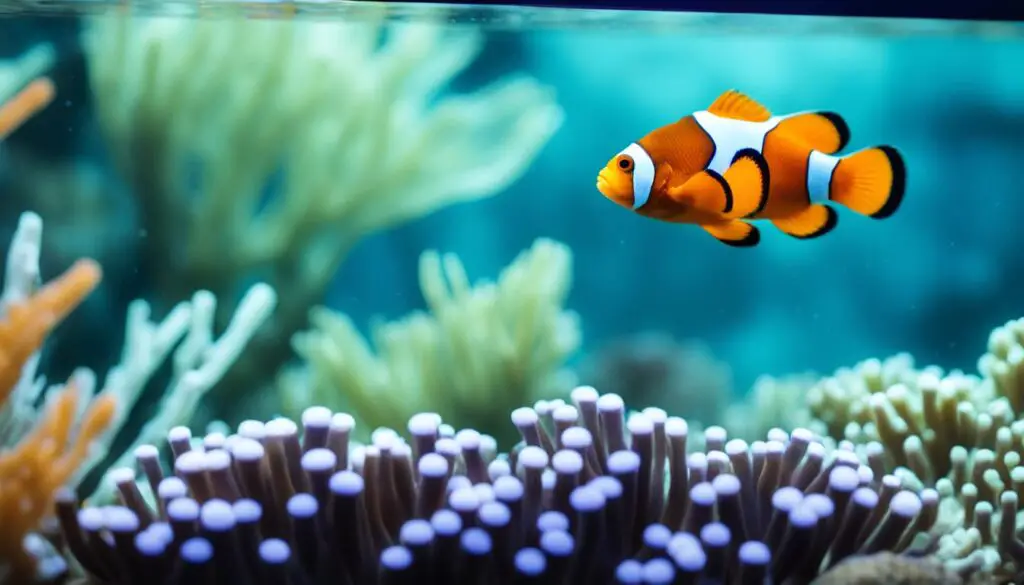Clownfish And Anemones: A Symbiotic Underwater Ballet

Introduction
Clownfish And Anemones: The clownfish, with its vibrant colors and endearing personality, has captured the hearts of both marine enthusiasts and the general public alike. Made famous by the animated film “Finding Nemo,” these small, comical fish are often associated with their seemingly symbiotic relationship with sea anemones. But the question that has intrigued researchers and aquarium hobbyists for years is.
In this exploration of the intriguing bond between clownfish and anemones, we delve into the fascinating world of these marine creatures. Clownfish, formally known as anemonefish, belong to the family Pomacentridae and are primarily found in the warm waters of the Pacific and Indian Oceans. Their unique relationship with sea anemones, which are essentially stationary, predatory animals related to coral reefs and jellyfish, is a subject of immense scientific interest.
For many, the idea of a fish living in harmony with a creature armed with stinging tentacles may seem counterintuitive. However, this synergy serves as a captivating example of nature’s intricate web of dependencies. This relationship not only provides a safe haven for the clownfish but also offers several benefits to the anemone itself. To unravel the mysteries of this association, we must examine the key elements of this peculiar partnership, including protection, food, and shelter, and explore the evolutionary significance of this remarkable bond.

Are anemones good for clownfish?
This adaptation not only allows them to get near anemones without hesitation, but they often make their homes within the anemone’s tentacles for protection and food. The partnership between anemones and clownfish is known as mutualism because it provides benefits to both animals.
Anemones are indeed good for clownfish, as their mutualistic relationship is a testament to nature’s intricate adaptations and symbiotic partnerships. The association between clownfish and anemones provides several advantages for both parties.
First and foremost, anemones offer clownfish a secure and protective habitat. Anemones possess stinging tentacles armed with nematocysts, which are used to capture prey and defend against predators. However, clownfish have developed a remarkable immunity to these stings, allowing them to safely cohabitate within the anemone’s tentacles. This protection shields the clownfish from potential threats and provides a safe space for them to rest and lay their eggs.
Additionally, clownfish actively groom their anemone hosts by removing debris and parasites from their tentacles, contributing to the overall health and cleanliness of the anemone. In return, anemones benefit from the food scraps and detritus that clownfish bring to them, aiding in their nutrition.
The relationship between clownfish and anemones is a classic example of mutualism, where both species gain advantages, making it clear that anemones are indeed beneficial for clownfish. This extraordinary partnership not only highlights the intricate web of dependencies in nature but also demonstrates the adaptability and resilience of marine life, ensuring the survival and thriving of both species in their respective ecosystems.
What will clownfish host besides anemone?
Many clownfish will not go anywhere near anemones and some clownfish have been known to host too many things other than anemones like feather dusters and toadstool corals. The most common clownfish and anemone to pair are the Ocellaris or Clarkii clownfish with Bubble tip anemones.
Clownfish are famously known for their association with sea anemones, but in certain situations or environments, they may host other organisms or structures besides anemones. These alternative “hosts” can offer clownfish a place of refuge and protection, even though they lack the stinging tentacles and mutualistic benefits of anemones.
In the absence of anemones, clownfish may seek shelter in various coral species, such as stony corals or soft corals, which can provide a safe environment for them to avoid predators. Some species of clownfish, like the Pink Skunk Clownfish, are known to inhabit the tentacles of giant sea anemones less frequently than other species and may be more adaptable to utilizing alternative hosts. In captivity, clownfish can also form associations with artificial structures, like PVC pipe fittings or ceramic ornaments, which can mimic the sheltered spaces provided by anemones or natural coral formations.
While these alternative hosts lack the intricate mutualistic relationship that anemones offer, they can still serve as protective shelters for clownfish. However, it’s important to note that these associations are not as well-documented or researched as the classic clownfish-anemone partnership, and their prevalence in the wild can vary depending on the specific environmental conditions and clownfish species.
Will clownfish naturally host anemone?
There’s just something about the symbiosis of it. In nature, a clownfish cannot survive without a host anemone. They would simply be picked off by a predator as they would have no place to hide. In the relative safety of our small glass boxes, however, clownfish will be perfectly happy without a host anemone.
Clownfish, also known as anemonefish, have a remarkable ability to naturally host sea anemones in the wild. This association is not a random occurrence; instead, it is deeply ingrained in their biology and behavior. Clownfish and sea anemones have evolved a mutualistic relationship over millions of years, which benefits both parties.
Clownfish often create natural bonds with beautiful or bubble-tip sea anemones in the wild. The clownfish live in the anemone’s tentacles, protected from predators. Their tentacles contain nematocysts, which can kill other creatures but not clownfish due to their protective mucus. Sea anemones benefit from clownfish food scraps and protection.
Clownfish depend on anemones for their existence in their environments. Young clownfish undergo “host selection,” adapting to their anemone species’ stinging tentacles. After establishing this bond, they rarely leave their host anemone. This unique collaboration shows how these two species have adapted and coevolved and illustrates the fragile balance of ocean life.
Do clownfish need to be in pairs?
The couple won’t know how to spread the bullying with three other males, but quarantining one male could disturb this. Therefore, just two clownfish should be kept.
Although clownfish are generally shown as living in pairs, they don’t necessary need one. Clownfish live in a variety of social arrangements in the wild, and their demand for friendship varies.
Clownfish establish hierarchical social groupings in their anemone homes. These groups may have a dominant male and female and non-breeding subordinates. Even though they don’t reproduce, subordinates defend the anemone and care for the eggs and young.
When a breeding pair member dies or is removed, a dominant subordinate often sex changes to replace the absent mate. Clownfish can adjust to new situations without living in pairs due to their social flexibility.
Because of their intriguing courtship and breeding rituals, clownfish are popular aquarium pets. While it’s not necessary for their survival, owning a pair can allow aquarists to witness these fascinating behaviors and produce clownfish, which can be satisfying.
Clownfish can live in couples, but their social structure and partner needs vary by habitat and life stage.
What is a clownfish’s favorite anemone?
Bubble Tip Anemone
Clownfish grow without host anemones. However, they usually accept them. Ocellaris clownfish can be kept with several host anemones, including the tough Bubble Tip Anemone (Entacmaea quadricolor).
Clownfish have no definitive “favorite” anemone. Instead, their choice of anemone host relies on their location, anemone species availability, and clownfish adaptations.
Different clownfish appreciate different anemones. Western and Eastern clownfish (Amphiprion ocellaris and percula) prefer the magnificent sea anemone (Heteractis magnifica) as hosts.
Certain anemones attract clownfish. Tomato Clownfish (Amphiprion frenatus) may benefit from bubble-tip anemones. How closely an anemone is to other sorts in the wild and how well it can adapt to them can also change its type.
Also, some anemones may offer better protection or better conditions for a certain type of clownfish. They tend to stay with their mother anemone once they have formed a bond with it. So, the idea of a clownfish’s “favorite” anemone is not the same for all species. It really depends on the species and the place, as well as a lot of biological and environmental factors.
Do clownfish need anemones to survive?
Not like in “Finding Nemo,” clownfish need anemones to survive. Clownfish can survive without anemones, but their relationship with them is fascinating and mutually beneficial.
Some sea anemones and clownfish create symbioses in the wild. Their stinging tentacles protect clownfish from predators, and clownfish in turn supply food scraps and protection from reef dwellers. Both parties benefit from mutualism.
Anemone-free aquariums can support clownfish in captivity. They hide in coral formations or rock crevices for protection. In a tank without anemones, clownfish must have clean water, a balanced food, and safe tankmates.
Clownfish don’t need anemones to survive, but they add character and help their health. Clownfish can thrive in captivity without their symbiotic partners with adequate care.
Do clownfish require a specific tank size?
Since “Finding Nemo,” clownfish have been seen a lot in tanks. Before you decide what size tank these bright fish need, you should think about a few things.
In general, the minimum tank size for keeping clownfish is about 20-30 gallons (75-115 liters). However, the specific tank size can vary depending on the species of clownfish and the number of individuals you intend to keep. Larger species may require more space, and it’s crucial to consider the potential growth of the fish and their swimming habits. A larger tank provides better water quality stability, more swimming space, and room for suitable tank mates.
Another crucial consideration is the inclusion of a host anemone if you plan to keep clownfish in a reef aquarium. Anemones can add to the bioload of the tank and may need additional space to accommodate their growth.
Proper filtration and water quality maintenance are essential, as clownfish are sensitive to water parameters. Regular monitoring of parameters like temperature, salinity, pH, and ammonia levels is crucial to their well-being.
There is a minimum tank size recommendation, but you must research the clownfish species you want to keep and consider tank mates and anemones.
Do clownfish lay their eggs in an anemone?
The “clownfish,” which lives with harmful sea anemones, does better. cleans and feeds anemone. Fish can hide and lay eggs in the anemone.
Anemones are catfish nests. Two species coordinate to help each other. This fantastic action proves it. Clownfish enjoy coral reef sea anemones of many types. Their stripes and brightness make them stand out.
The anemone’s bite prevents animals from eating clownfish. To avoid clownfish, which are food scraps, reef fish avoid anemone stems.
This unusual interaction between clownfish and anemones shows how marine life has adapted to coral reefs’ complex and competing ecosystems.

Conclusion
In our quest to understand the question of whether clownfish truly need sea anemones, we have uncovered a wealth of fascinating insights into the intricacies of nature’s relationships. While it is clear that clownfish do not absolutely require anemones for their survival, these sea creatures have developed a remarkable and mutually beneficial partnership over millions of years of evolution.
Clownfish and Anemones derive essential benefits from their association with anemones, including protection from predators, access to a ready source of food, and a safe environment to lay their eggs. This partnership has allowed clownfish to thrive in their respective ecosystems, showcasing the adaptability of nature’s creations.
This association is a testament to the intricate balance of give and take in the natural world. Clownfish and Anemones receive food scraps and protection from clownfish, who diligently clean and defend their hosts. The coexistence of these two species illustrates how even seemingly disparate organisms can harmoniously coexist when they each provide unique advantages to one another.
While clownfish can survive without anemones, these vibrant fish continue to choose these stinging creatures as their preferred shelter. This choice, however, comes with no guarantees. As we continue to study and appreciate the complex relationships that make up the rich tapestry of marine life, the partnership between clownfish and anemones remains a captivating example of the wonders of the underwater world, offering valuable insights into the delicate balance of life in the oceans.



